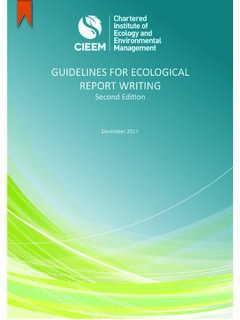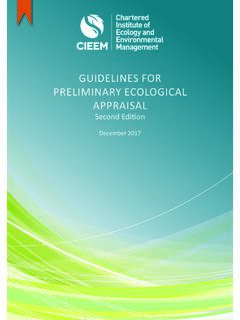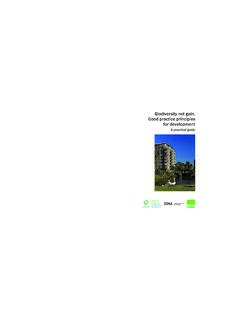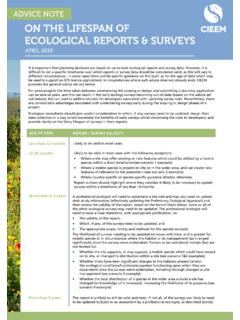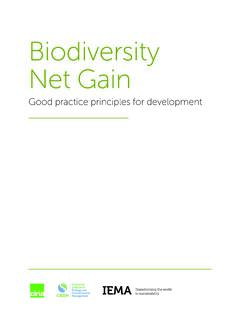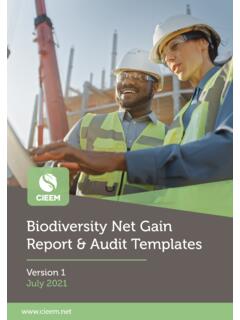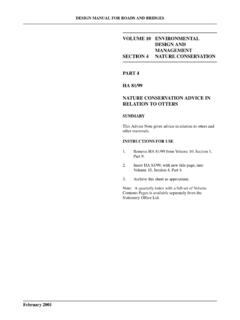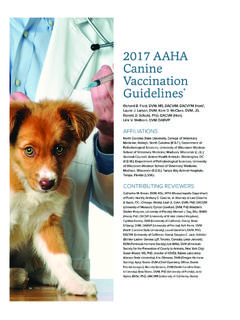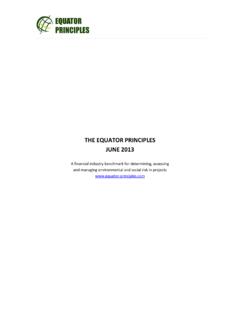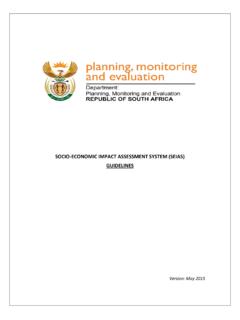Transcription of GUIDELINES FOR ECOLOGICAL IMPACT ASSESSMENT IN THE …
1 GUIDELINES FOR. ECOLOGICAL IMPACT ASSESSMENT . IN THE UK AND IRELAND. Terrestrial, Freshwater, Coastal and Marine September 2018. CIEEM 2018. CONTENTS. AMENDMENTS AND CORRECTIONS .. iii PREFACE .. iiiv ACKNOWLEDGEMENTS .. vii SUMMARY .. vii 1. INTRODUCTION .. 1. Use of the GUIDELINES .. 2. Differing Scales of EcIA and a Proportionate Approach .. 2. A Rigorous and Transparent 3. Key Principles .. 4. The EcIA Process .. 4. 2. SCOPING .. 8. Purpose and Objectives of Scoping .. 8. The Scoping Process .. 9. Conclusions of the Scoping 17. 3. ESTABLISHING THE BASELINE .. 19. Introduction .. 19. Considering Other Development Projects when Predicting the Baseline .. 20. Informing the Baseline .. 19. Data .. 20. 4. IMPORTANT ECOLOGICAL FEATURES.
2 21. Introduction .. 21. Determining Importance .. 21. 5. IMPACT ASSESSMENT .. 28. Introduction .. 28. Predicting ECOLOGICAL Impacts and Effects .. 29. Characterising ECOLOGICAL Impacts .. 30. ASSESSMENT of Cumulative Impacts and Effects .. 32. ASSESSMENT of Residual Impacts .. 33. Significant 33. Determining Ecologically Significant Effects .. 34. Precautionary Principle .. 35. The Marine Context .. 35. Alternative 35. Example ASSESSMENT of the Significance of Effects .. 36. i 6. AVOIDANCE, MITIGATION, COMPENSATION AND 37. Introduction .. 37. Avoidance and Mitigation .. 37. Compensation .. 37. 38. Designing Mitigation and Compensation .. 39. Delivery .. 39. Reporting Mitigation, Compensation and 40. Monitoring.
3 40. 7. CONSEQUENCES FOR DECISION-MAKING .. 42. Introduction .. 42. Legal Implications .. 42. Policy Implications .. 43. Implications for Detailed Design and Implementation .. 43. APPENDIX 1 Example ASSESSMENT of the Significance of Effects (Terrestrial) .. 45. APPENDIX 2 Example ASSESSMENT of the Significance of Effects (Marine) .. 54. APPENDIX 3 Template for ECOLOGICAL IMPACT ASSESSMENT .. 64. APPENDIX 4 Sources of Contextual Information .. 71. GLOSSARY .. 72. LIST OF 75. ENDNOTES .. 76. ii AMENDMENTS AND CORRECTIONS. Note: Minor typographical revisions and weblink updates will not be shown here but will be incorporated into the PDF version available on the CIEEM website on an ongoing basis. iii PREFACE. The GUIDELINES for ECOLOGICAL IMPACT ASSESSMENT in the UK and Ireland (2018) combines the GUIDELINES for ECOLOGICAL IMPACT ASSESSMENT in the UK and Ireland: Terrestrial, Freshwater and Coastal, 2nd edition (2016) and the GUIDELINES for ECOLOGICAL IMPACT ASSESSMENT in Britain and Ireland: Marine and Coastal (2010).
4 The aim of the GUIDELINES is to: promote good practice promote a scientifically rigorous and transparent approach to ECOLOGICAL IMPACT ASSESSMENT (EcIA). provide a common framework to EcIA in order to promote better communication and closer cooperation between ecologists involved in EcIA. provide decision-makers with relevant information about the likely ECOLOGICAL effects of a project. Biodiversity: Code of practice for planning and development1 published by the British Standards Institute (BS 42020:2013) cites the CIEEM EcIA GUIDELINES as the acknowledged reference on ECOLOGICAL IMPACT ASSESSMENT . The GUIDELINES are consistent with the British Standard on Biodiversity, which provides recommendations on topics such as professional practice, proportionality, pre-application discussions, ECOLOGICAL surveys, adequacy of ECOLOGICAL information, reporting and monitoring.
5 This document should be referenced as: CIEEM (2018) GUIDELINES for ECOLOGICAL IMPACT ASSESSMENT in the UK and Ireland: Terrestrial, Freshwater, Coastal and Marine. Chartered Institute of Ecology and Environmental Management, Winchester. The following organisations have contributed to these GUIDELINES and have provided the statements below: The Environment Agency provided advice to the development of this guidance and believe it has a good appreciation of the links between the coastal and terrestrial environment for operational, advisory, and regulatory roles. Natural England contributed to the development of this document and see merit in its publication. The Marine Management Organisation (MMO) promotes sustainable development in our marine area and delivers the Government aim for clean, healthy, safe, productive and biologically diverse oceans and seas.
6 The GUIDELINES for ECOLOGICAL IMPACT ASSESSMENT in the UK and Ireland provide a robust reference for undertaking EcIA assessments in our coastal and marine environment. Marine Scotland Science welcomes this revision of CIEEM EcIA GUIDELINES as a contribution towards integration of EIA methods across terrestrial and aquatic environments. iv The following organisations have contributed to and endorse these GUIDELINES . v ACKNOWLEDGEMENTS. CIEEM would like to thank all those involved in the production of these GUIDELINES : The Technical Review Group for these GUIDELINES included Richard Arnold, John Box (Joint Editorial Chair), Diane Corfe, Cameron Crook, Mike Dean, Bob Edmonds, Nathan Edmonds, Mick Green, Richard Knightbridge, Tom Mallows, Caroline McParland, Roger Morris (Joint Editorial Chair), Tim Norman, Graham Russell, Colin Scott, Jo Treweek, Duncan Watson and Jim Wilson.
7 Once again David Pape and Jacklyn Johnston (NatureConsult) brought significant technical expertise and practical insight to their role as editors. The GUIDELINES are a much- improved document for their input. David Tyldesley (DTA Associates) contributed invaluable expert opinion in key areas. CIEEM is also grateful for the significant contributions from Simon Boulter, Rhian Brimble, Paul Burgess, Larry Burrows, Mary Chadwick, Karen Colebourn, Angus Corby, Judith Cox, Kathy Dale, John Dobson, Katherine Drayson, David Dutton, Pete Etheridge, Helen Evriviades, Jim Fairclough, Josh Fothergill, Simon Geary, Mick Hall, Lorna Harris, Claire Lacey, William Latimer, Helen Lucking, Cameron MacIver, Chris Manning, Orla Maguire, James McCrory, Anne Murray, Steve Mustow, Jenny Neff, Tadhg O'Mahony, Mike Oxford, David Parker, Diana Reynolds, Louise Scally Paul Scott, Annie Say, Aedan Smith, George Smith, Andrea Taylor, Jon Taylor, Andre Thiel, Claire Wansbury, Sandra Wells, David Whitehorne, Mike Willis.
8 Matthew Wilson, Stephanie Wray and Len Wyatt. CIEEM would also like to acknowledge the support provided by the following organisations: ABPmer AMEC Foster Wheeler Environment & Infrastructure UK Ltd. Association of Local Government Ecologists Atkins Ltd CEFAS. Chartered Institution of Water and Environmental Management Crown Estate Department of Agriculture, Environment and Rural Affairs (NI). Ecology Matters Environment Agency (England). Institute of Environmental Management and ASSESSMENT Jacobs UK Ltd MD Ecology National Parks and Wildlife Service (Ireland). Natural England Natural Resources Wales NIRAS Consulting Royal Society for the Protection of Birds Scottish Environment Protection Agency Scottish Natural Heritage SLR Consulting Ltd The Wildlife Trusts Thomson Ecology vi SUMMARY.
9 The Chartered Institute of Ecology and Environmental Management (CIEEM) has developed these GUIDELINES to promote good practice in ECOLOGICAL IMPACT ASSESSMENT (EcIA) relating to terrestrial, freshwater, coastal and marine environments in the UK and Ireland. EcIA is a process of identifying, quantifying and evaluating potential effects of development- related or other proposed actions on habitats, species and ecosystems2. The findings of an ASSESSMENT can help competent authorities understand ECOLOGICAL issues when determining applications for consent. EcIA can be used for the appraisal of projects of any scale including the ECOLOGICAL component of Environmental IMPACT ASSESSMENT (EIA). When undertaken as part of an EIA, EcIA is subject to the relevant EIA Regulations.
10 Unlike EIA, EcIA on its own is not a statutory requirement. It is an evaluation process undertaken to support a range of assessments. EcIA is a process that is most effective if all contributing ecologists and other specialists work in collaboration. An EcIA report (or the ECOLOGICAL chapter of an EIA Environmental Statement) should clearly and simply describe the significant effects of any project so that all interested parties understand the implications of what is proposed. These GUIDELINES explain the key elements of the EcIA process: Chapter 1 Introduction. Overview of the EcIA process and underpinning principles. Chapter 2 Scoping. Determining the matters to be addressed in the EcIA, including consultation to ensure the most effective input to defining the scope.
